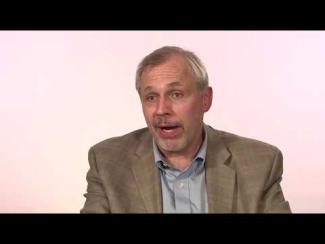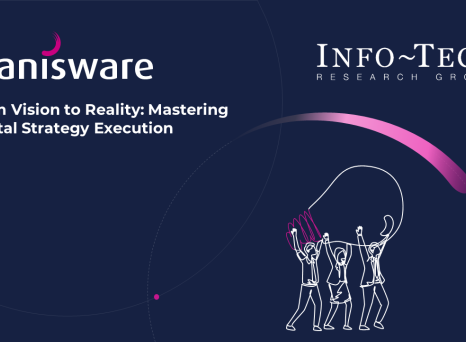X
My name is Mike Wiebe and I'm the founder and president of M.J. Wiebe & Associates, Inc.
Could you please describe your company? (0:11 to 0:32)
We help organizations to get better at creating products and services, and taking them into market.That could be everything from strategy right down through to the business process pieces. Traditionally, we've done that with large, multi-national organizations, but more recently, we've found a very, very willing audience in small and medium enterprises looking to do the same things.
Our business is multi-national. I've had the pleasure of working across virtually every industry out there in most major developing areas of the world, or developed areas of the world. And again, large and small. It's fascinating and it's fun to see all the differences, and it's kind of what keeps me interested in this, as well, seeing all the different approaches.
What do you like most about working with large organizations? (0:52 to 01:10)
I think working with large organizations, some of the advantages are the breadth of what they do. The influence they wield and, often, the interesting brands, and the ability to actually step away and go, "Wow, I was able to teach them something, but I learned a lot from them and their brand, as well."
What key process challenges do large NPD organizations face? (01:15 to 01:37)
In a word: Bureaucracy. Many organizations have created processes that are so complex that it's almost impossible to unravel them and improve them. The net result is any improvements that are undertaken typically would be incremental, at best. Often times, organizations are losing sight of why they have these processes and the process exists for the sake of the process.
What do you like about working with SME?(01:40 to 02:02)
The fun of working with small organizations is the nimbleness and the speed. They're quite willing to make decisions. Typically, we find more often they're privately owned and, so, they're not at the beck and call of the quarterly analyst conference call, and the net result is they're more in command and control of the decisions they make to run their own business.
What common SME practices should large organizations adopt? (02:08 to 02:41)
I think, largely, the major differences that I see are that the small organizations are spending less time on details of the process and more time on the decision-making components. The small, medium organization is scared by process and I think it's a positive for them because as their organizations grow, they know they need to make decisions in a different way and so they tend to focus at the decision level and less at building those forms and templates and details of process.
And, so that -- I think -- is something that the large companies can learn to adapt.
What are the first steps for any company to move toward structured portfolio decision-making? (02:46 to 04:08)
It's actually a fairly simple set of things they can do. Number one is to understand the projects underway in the organization and that's easily said, but oftentimes there's a lot more going on than people know, so getting a truly good inventory.
Number two would be to understand the resources available, so what's the capacity to work on projects?
The third thing that goes hand-in-hand with those two things then is to ruthlessly draw a line. Most organizations have way too many projects and the first step in good portfolio management is to get back to a capacity that makes sense.
Last but not least then, I think, is the projects you do undertake, they have to be aligned with the vision and strategy of the business, so the real purpose of portfolio management is to connect those dots between strategy and the things we work on day-to-day. I did this for years in a major corporation long before portfolio management was popular, and the analogy that seemed to work best back then, and it still plays well today, is it think about portfolio management the way you think about your retirement portfolio, and we all make decisions on where to invest. Stocks and bonds and real estate, and we do that based on our retirement needs, our personal strategies. So, in business, it may not be stocks, bonds, and real estate, but it may be things like our markets, the risk of our projects we're undertaking, our business lines, things like that.
And, so, making those parallels, I think, makes it easier for companies to make decisions on portfolio, if you use that retirement planning analogy.
What can SMEs learn from large organizations? (04:14 to 05:00)
A maturing company, so back to the small and medium enterprise and thinking about how they would actually use some of these large businesses' experiences to move forward. A couple of things. Number one is to not be scared of process used the correct way. So, many small, medium organizations are really, really fearful of creating the bureaucracy that eliminates the nimbleness of their organization. The companies that are successful at this recognize that process is not a dirty word. It's a good word if you use it appropriately inside the organization, so it's not process for process sake, but it's process based on a set of principles that allows you to accomplish what you're trying to accomplish. Big companies actually do that fairly well, when they step back and think about it, and small companies can learn from that, I think.
What can a company that already has established processes do? (05:01 to 05:36)
Companies that already have decent, established processes, I think the most important thing they can do is to lean them out, and it's an overused word, but the idea, again, of starting from the top-down and thinking about, "What is the decision we're trying to make here?" And the decision, fundamentally, is around assigning resources to projects, so in that environment, how can I make the decisions in the simplest ways? What information do I need to use, to get, to make those decisions, and how will I getthat information? So it's designing your improvements from the top-down, not from the process-up at the bottom.
How can a company prepare for organizational change? (05:39 to 06:25)
Change is difficult. Change in any aspect is difficult for us as adults and we all resist it naturally. In my experience, starting the change at the top is critical, and by that, I don't mean that the boss mandates the change. So, it's not this, the train is moving, get on or stay behind, but that the boss recognizes the change probably involves them as well. And, so, if they start to actually show that they're willing to change, and they describe why the change is important to the organization, that's a great first step.
That naturally flows into change deeper in the organization, because there's an old adage that says, "What interests my boss fascinates the hell out of me." And if that is honest and comes with integrity from the boss, we're much more likely as the people in the organization to follow that.
What are some lessons imparted by Dr. Robert Cooper? (06:28 to 07:29)
Well, I think anybody who's worked with Bob in the past would know that the best lessons are probably not lessons that could be shared in a taped video. But having said that, I would say there's a couple things. Over a period of about 12 years, I've learned an awful lot from Bob. The things that stand out most are, "Don't over-complicate the analysis or the solution." There's a lot that continues to change. We've seen different project management methodologies. We've seen lean, we've seen waterfall development, we've seen agile development. Behind all those things, there's some key business premises that continue to support those things. So, it's not that it's "flavor of the day," but all these things work well together and the magic is in finding the right solution between how you operate and how you make your decisions.
Probably the last thing is, never do this unless you're having fun, and it's clear that he continues to have fun. It's probably the reason I'm still involved is because he's made it fun for me to do this.



